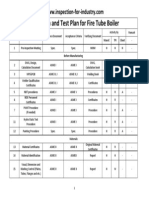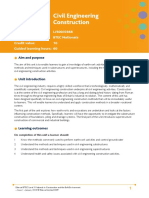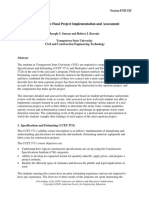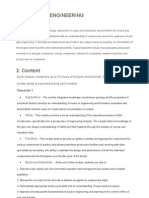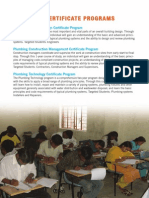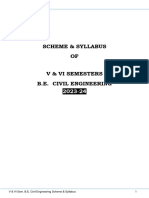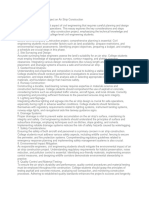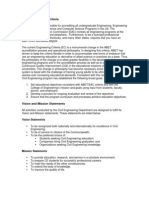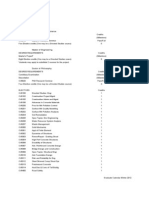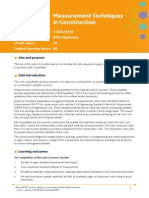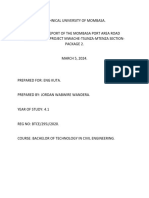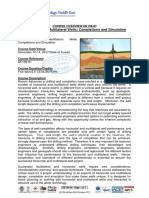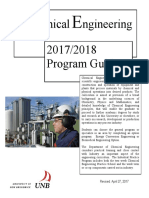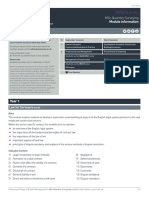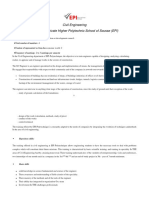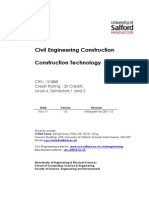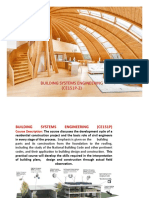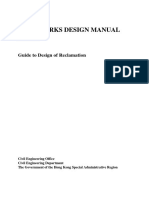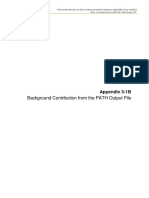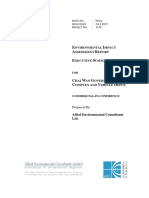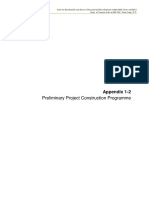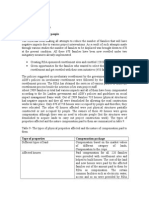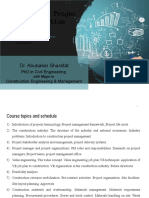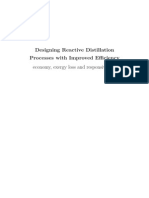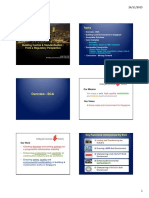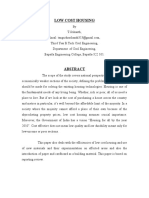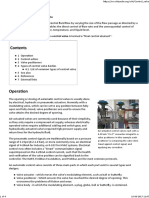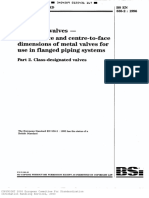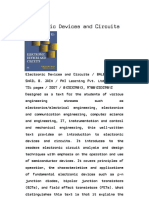Advanced Civil Engineering
Advanced Civil Engineering
Uploaded by
dist2235Copyright:
Available Formats
Advanced Civil Engineering
Advanced Civil Engineering
Uploaded by
dist2235Original Description:
Copyright
Available Formats
Share this document
Did you find this document useful?
Is this content inappropriate?
Copyright:
Available Formats
Advanced Civil Engineering
Advanced Civil Engineering
Uploaded by
dist2235Copyright:
Available Formats
UNIT 37: ADVANCED CIVIL ENGINEERING
Unit 37:
Unit code: QCF level: Credit value:
Advanced Civil Engineering
T/601/1316 5 15
Aim
This unit enables learners to understand the methods and techniques used for specialised civil engineering projects and develop skills in solving problems arising from construction and civil engineering activities.
Unit abstract
This unit provides learners with an understanding of specialised methods and techniques used in complex civil engineering activities. There is a strong theoretical understanding underpinning the study of this unit, and there will be considerable emphasis on learners understanding the selection of appropriate methods and resources through a variety of realistic case studies.
1 2 3 4 5
Learning outcomes
Understand the methods and techniques used in tunnelling activities Understand the methods and techniques used in hydraulic structures Understand the methods and techniques used in marine works Understand the methods and techniques used in highway construction and railway works Be able to solve problems arising from complex civil engineering activities.
On successful completion of this unit a learner will:
BH029571 Edexcel BTEC Levels 4 and 5 Higher Nationals specification in Construction and the Built Environment Issue 2 August 2011 Edexcel Limited 2011
185
UNIT 37: ADVANCED CIVIL ENGINEERING
Unit content
Understand the methods and techniques used in tunnelling activities Tunnelling activities: ground conditions eg hard rock, soft ground; ground support; cut and cover tunnelling; pipejacking; mini-tunnelling; construction of shafts
Understand the methods and techniques used in hydraulic structures Constructing hydraulic structures: materials used eg earth, rockfill, concrete; ancillary works; canal and river works
Understand the methods and techniques used in marine works Constructing marine works: cofferdams; caissons; sea walls; harbour works; coastal protection activities
Understand the methods and techniques used in highway construction and railway works Constructing and maintaining carriageway works: rigid pavements; flexible pavements; railway works (provision of new track and ancillary structures)
Be able to solve problems arising from complex civil engineering activities Factors affecting solutions to civil engineering problems: proper regard to health, safety and welfare; environmental issues; quality matters; technical and economic considerations; importance of resource plan, planning and programming; contingency plans; amendments as necessary
186
BH029571 Edexcel BTEC Levels 4 and 5 Higher Nationals specification in Construction and the Built Environment Issue 2 August 2011 Edexcel Limited 2011
UNIT 37: ADVANCED CIVIL ENGINEERING
Learning outcomes and assessment criteria
Learning outcomes
On successful completion of this unit a learner will: LO1 Understand the methods and techniques used in tunnelling activities LO2 Understand the methods and techniques used in hydraulic structures LO3 Understand the methods and techniques used in marine works LO4 Understand the methods and techniques used in highway construction and railway works LO5 Be able to solve problems arising from complex civil engineering activities
Assessment criteria for pass
The learner can: 1.1 explain construction methods for tunnelling 1.2 illustrate appropriate methods used in tunnels and shafts 2.1 explain construction methods for hydraulic structures 2.2 illustrate appropriate methods used in hydraulic structures 3.1 explain construction methods for marine works 3.2 illustrate appropriate methods used in marine works 4.1 explain construction methods for highway and railway works 4.2 illustrate appropriate methods used in highway construction and railway works 5.1 design appropriate solutions for complex civil engineering activities 5.2 produce a resource plan for civil engineering activities
BH029571 Edexcel BTEC Levels 4 and 5 Higher Nationals specification in Construction and the Built Environment Issue 2 August 2011 Edexcel Limited 2011
187
UNIT 37: ADVANCED CIVIL ENGINEERING
Guidance
Links
This unit links with other Edexcel BTEC HN Construction and the Built Environment units, for example:
Unit 1: Design Principles and Application for Construction and the Built Environment Unit 4: Management Principles and Application for Construction and the Built Environment Unit 13: Environmental Impact of Construction Unit 15: Production Management for Construction Unit 27: Site Surveying Procedures for Construction and the Built Environment Unit 33: Civil Engineering Technology Unit 38: Hydraulic Principles and Applications.
The content of this unit has been designed and mapped against the current CIC National Occupational Standards and the current NVQs at levels 4 and 5. Completion of the learning outcomes will contribute knowledge, understanding and skills towards the evidence requirements of the NVQs.
See Annexe B for summary of mapping information to NVQs.
This unit has also been mapped to illustrate the links to the NQF units. See Annexe D for summary of mapping information to NQF units.
Essential requirements
It is essential that a culture of health and safety is embedded in all the units to ensure that the learners understand the importance and relevance of health and safety issues. Therefore there should be clearly signposted aspects of current legislation and health, safety and welfare implications throughout the delivery and assessment of this unit.
Employer engagement and vocational contexts
Tutors should organise site visits to two different civil engineering works. To ensure site visits are successful tutors should brief learners on the of scope of works, health, safety and welfare requirements and associated problems with tunnelling, marine, highways or complex civil engineering works. Tutors should outline the aims and objectives of the visits and encourage learners to review the site visits and compare construction techniques used on site works. Tutors should organise presentations by visiting speakers, for example contractors to contextualise site visits. Tutors should use real-life case studies, based on site visits, for example, tunnelling and temporary works associated with earthworks and earthwork removal, and/or management of complex marine or highway civil engineering projects, including relevant health, safety and welfare requirements. Tutors should encourage learners to produce written solutions supported by oral presentations.
188
BH029571 Edexcel BTEC Levels 4 and 5 Higher Nationals specification in Construction and the Built Environment Issue 2 August 2011 Edexcel Limited 2011
You might also like
- Life Orientation CAT Part A 2024Document22 pagesLife Orientation CAT Part A 2024dhivy.govender100% (1)
- BPS-Handbook 2019 enDocument116 pagesBPS-Handbook 2019 enLuisaSarmento88% (8)
- Regulations Handbook-DEWADocument93 pagesRegulations Handbook-DEWArksubu82100% (5)
- Example Professional ReportDocument5 pagesExample Professional ReportyusufNo ratings yet
- Overview On The Development of Green Buildings Codes For KuwaitDocument46 pagesOverview On The Development of Green Buildings Codes For Kuwaitmohammed_nasrullah_1No ratings yet
- Integrated Project Planning and Construction Based on ResultsFrom EverandIntegrated Project Planning and Construction Based on ResultsNo ratings yet
- Inspection and Test Plan For Fire Tube BoilerDocument4 pagesInspection and Test Plan For Fire Tube BoilerJayaram MV100% (1)
- Architecture Books Download IndexDocument18 pagesArchitecture Books Download IndexVirendra K. GajbhiyeNo ratings yet
- Unit 29 Construction in Civil EngineeringDocument15 pagesUnit 29 Construction in Civil EngineeringrachuNo ratings yet
- Unit 51 Civil Engineering ConstructionDocument12 pagesUnit 51 Civil Engineering ConstructionmikeNo ratings yet
- Mini Capstone Final Project Implementation and AssessmentDocument8 pagesMini Capstone Final Project Implementation and AssessmentSodium ChlorideNo ratings yet
- GT Lab Manual PDFDocument92 pagesGT Lab Manual PDFDharmaraaj RajalinggamNo ratings yet
- List of Modules Offered in Academic Year 2013/2014: Department of Civil & Environmental EngineeringDocument22 pagesList of Modules Offered in Academic Year 2013/2014: Department of Civil & Environmental EngineeringLinus TanNo ratings yet
- What We LearnDocument42 pagesWhat We Learn木辛耳总No ratings yet
- Civil Eng ConstructionDocument8 pagesCivil Eng ConstructionMohamed ReezaNo ratings yet
- Content Standard Performance StandardDocument7 pagesContent Standard Performance StandardRolly James Antonio GabuyoNo ratings yet
- FE SE TE BE Civil Course Outcomes 4-10-15Document24 pagesFE SE TE BE Civil Course Outcomes 4-10-15Ashok RajanavarNo ratings yet
- Course BrochuresDocument2 pagesCourse BrochuressleekenderNo ratings yet
- India Inserts AcademicCertificateProgramsDocument1 pageIndia Inserts AcademicCertificateProgramsRavi ChandranNo ratings yet
- HNC Electrical Engineering SunderlandDocument16 pagesHNC Electrical Engineering SunderlandTy WilsonNo ratings yet
- Prescription of Qualifications ARB CriteriaDocument14 pagesPrescription of Qualifications ARB CriterianickytovtNo ratings yet
- Revised and Compressed Bme 700oeDocument147 pagesRevised and Compressed Bme 700oeTERALA BHANUPRAKASHNo ratings yet
- Geotechnical ApplicationsDocument3 pagesGeotechnical ApplicationsCHEL TAKNo ratings yet
- CV 5 6 2023 24Document49 pagesCV 5 6 2023 24Mohammed FurqanNo ratings yet
- Ce 172 - 1Document38 pagesCe 172 - 1Czarlon Jade LactuanNo ratings yet
- TitleDocument3 pagesTitleRoseNo ratings yet
- Assessment of Engineering Attributes For Abet AccreditationDocument6 pagesAssessment of Engineering Attributes For Abet AccreditationPS nptelNo ratings yet
- AbetDocument3 pagesAbetsaidhaggagNo ratings yet
- 2024 Engineering ProspectusDocument110 pages2024 Engineering Prospectuswinnie FikileNo ratings yet
- Highway Engineering Lab-Mvj19cvl57Document34 pagesHighway Engineering Lab-Mvj19cvl57Vetrivel NagarajanNo ratings yet
- Undergraduate Student Handbook RevisedDocument45 pagesUndergraduate Student Handbook Revisednalanth76No ratings yet
- RU Civil Engineering CurriculumDocument6 pagesRU Civil Engineering CurriculumEgyptian ResearcherNo ratings yet
- RIICWD512E Student Guide v1.1Document42 pagesRIICWD512E Student Guide v1.1jalandargcNo ratings yet
- Civil Engineering ProgramDocument14 pagesCivil Engineering ProgramTadesse MegersaNo ratings yet
- Unit 47 Measurement Techniques in ConstructionDocument11 pagesUnit 47 Measurement Techniques in ConstructionAnonymous vmeAM32w0% (1)
- Bridge Report HeskyDocument6 pagesBridge Report Heskycalvin ouroNo ratings yet
- 1A Assignment 1 - Construction Technology and Environmental ServicesDocument1 page1A Assignment 1 - Construction Technology and Environmental Servicesratneshtripathi1412No ratings yet
- 9.2.2 Programme Objectives: Day 1 Session 2/3Document33 pages9.2.2 Programme Objectives: Day 1 Session 2/3JithinAbrahamNo ratings yet
- DE159-IH OverviewDocument7 pagesDE159-IH OverviewIbrahim DewaliNo ratings yet
- 1718 GuideDocument16 pages1718 GuidevonrongeNo ratings yet
- Course & Code: Projects & Seminars-Ii (Ce10601)Document2 pagesCourse & Code: Projects & Seminars-Ii (Ce10601)maheshNo ratings yet
- UCEM PG QS Module Info 081215Document6 pagesUCEM PG QS Module Info 081215thirudan thiruNo ratings yet
- 21549B - Building Construction Technology - H1 PDFDocument6 pages21549B - Building Construction Technology - H1 PDFLokuliyanaNNo ratings yet
- Port Manual 3 Guide To Design of ReclamationDocument133 pagesPort Manual 3 Guide To Design of Reclamationpn100% (1)
- PC LAB Workbook - 17.12.2016Document71 pagesPC LAB Workbook - 17.12.2016y satishkumarNo ratings yet
- Civil Objective Module Matrixes Finale 1Document15 pagesCivil Objective Module Matrixes Finale 1Montasar MbarkiNo ratings yet
- E410F Syllabus Civil EngDocument13 pagesE410F Syllabus Civil EngRichard BernieNo ratings yet
- Ce 333Document4 pagesCe 333binoNo ratings yet
- D2j7-Cec 202021Document8 pagesD2j7-Cec 202021ran2315570No ratings yet
- Beng Electro Mechanical EngineeringDocument11 pagesBeng Electro Mechanical EngineeringCarlo Anacoreta DueNo ratings yet
- Ecc 584 Integrated Design ProjectDocument21 pagesEcc 584 Integrated Design ProjectNurul NazurahNo ratings yet
- EQTips FullDocument15 pagesEQTips FullNeha ChauhanNo ratings yet
- الخطة الدراسيةDocument390 pagesالخطة الدراسيةZaidoon MohsinNo ratings yet
- Civil Engineering ConstructionDocument91 pagesCivil Engineering ConstructionAli Saeed50% (2)
- EPL_Manual_FullDocument129 pagesEPL_Manual_Fullrvasanthraj31No ratings yet
- Building Systems - IntroductionDocument18 pagesBuilding Systems - IntroductionJustine Torres100% (1)
- Port Works Design Manual Part 3 (Guide To Design of Reclamation) 2002Document128 pagesPort Works Design Manual Part 3 (Guide To Design of Reclamation) 2002Han JD100% (1)
- Port Reclamation GuideDocument60 pagesPort Reclamation GuidepnNo ratings yet
- Ee 182 - ObeDocument5 pagesEe 182 - ObeMichael Calizo PacisNo ratings yet
- Construction Studies Project Guide Edit 28 2 10Document16 pagesConstruction Studies Project Guide Edit 28 2 10api-268972981100% (1)
- Career Change From Real Estate to Oil and Gas ProjectsFrom EverandCareer Change From Real Estate to Oil and Gas ProjectsRating: 5 out of 5 stars5/5 (1)
- Project Management Casebook: Instructor's ManualFrom EverandProject Management Casebook: Instructor's ManualNo ratings yet
- Concrete Structures: Repair, Rehabilitation and StrengtheningFrom EverandConcrete Structures: Repair, Rehabilitation and StrengtheningNo ratings yet
- Background Contribution From The PATH Output File: Appendix 3-1BDocument2 pagesBackground Contribution From The PATH Output File: Appendix 3-1Bdist2235No ratings yet
- Construction Programme of The Adjacent Planned Development ProjectsDocument3 pagesConstruction Programme of The Adjacent Planned Development Projectsdist2235No ratings yet
- Lect01 - Technical Drawing Exercises PDFDocument12 pagesLect01 - Technical Drawing Exercises PDFdist2235No ratings yet
- Executive Summary (Eng) FinalDocument22 pagesExecutive Summary (Eng) Finaldist22350% (1)
- Water ProofingDocument124 pagesWater Proofingdist2235No ratings yet
- Hamill 2011 - Solutions Chapter 02Document5 pagesHamill 2011 - Solutions Chapter 02dist2235No ratings yet
- Preliminary Project Construction Programme: Appendix 1-2Document2 pagesPreliminary Project Construction Programme: Appendix 1-2dist2235No ratings yet
- CDM Worked ExampleDocument211 pagesCDM Worked ExampleDheen MeeranNo ratings yet
- Chapter 3 Fluid StatisticsDocument50 pagesChapter 3 Fluid Statisticsdist2235No ratings yet
- Technical Drawing Exercises - SolutionsDocument5 pagesTechnical Drawing Exercises - Solutionsdist2235100% (1)
- Problem 1-2Document1 pageProblem 1-2dist2235No ratings yet
- Swanriver Additional NotesDocument10 pagesSwanriver Additional Notesdist2235No ratings yet
- Conservation of Energy: The Bernoulli Equation: Figure 1. A Very Large Venturi MeterDocument8 pagesConservation of Energy: The Bernoulli Equation: Figure 1. A Very Large Venturi Meterdist2235No ratings yet
- ENSC3003 - Fluid Mechanics Lab 3 Pumps: Student NameDocument14 pagesENSC3003 - Fluid Mechanics Lab 3 Pumps: Student Namedist2235No ratings yet
- Transition To Turbulence: Kerosene/Water Manometer Dye Reservoir KDocument6 pagesTransition To Turbulence: Kerosene/Water Manometer Dye Reservoir Kdist2235No ratings yet
- Problem 1-1Document1 pageProblem 1-1dist2235No ratings yet
- Solution: Conservation of EnergyDocument8 pagesSolution: Conservation of Energydist2235No ratings yet
- Section On Mitigation ADB1Document15 pagesSection On Mitigation ADB1dist2235No ratings yet
- CIVL2130/ENVE2602 Labs: The Swan River ModelDocument7 pagesCIVL2130/ENVE2602 Labs: The Swan River Modeldist2235No ratings yet
- Highway Engineering Lecturer Notes Chapter 1 2Document77 pagesHighway Engineering Lecturer Notes Chapter 1 2dist2235No ratings yet
- Chapter 5 JBICDocument40 pagesChapter 5 JBICdist2235No ratings yet
- Pavement Design and ConstructionDocument82 pagesPavement Design and Constructiondist2235No ratings yet
- Simplified Assessment of Bending Moment Capacity For RCDocument11 pagesSimplified Assessment of Bending Moment Capacity For RCAbhishek KumarNo ratings yet
- Rama University, Kanpur Rama University, KanpurDocument1 pageRama University, Kanpur Rama University, KanpurData ManagementNo ratings yet
- STTP - Quantum Intelligence & Generative AI - 2dec-2024Document3 pagesSTTP - Quantum Intelligence & Generative AI - 2dec-2024Tris PriorNo ratings yet
- Construction Projec T Administration: Dr. Abubakar SharafatDocument31 pagesConstruction Projec T Administration: Dr. Abubakar Sharafatmalik awansNo ratings yet
- Zasiah Tafheem - Seismic Isolation Systems in StructuresDocument17 pagesZasiah Tafheem - Seismic Isolation Systems in StructuresRafael RuizNo ratings yet
- Circular For Skill Based Training As An Option To Summer Internship - 550529Document15 pagesCircular For Skill Based Training As An Option To Summer Internship - 550529Darshan BarotNo ratings yet
- Singhania UniversityDocument20 pagesSinghania UniversityAMIN SHAIKHNo ratings yet
- Harvey 1969Document6 pagesHarvey 1969Fabiano SchmidtNo ratings yet
- Tension Flange Effective Width in Reinforced Concrete Shear Walls PDFDocument8 pagesTension Flange Effective Width in Reinforced Concrete Shear Walls PDFgrahambrasicNo ratings yet
- RES - Statement That Architectural (And ArchitecturalDocument36 pagesRES - Statement That Architectural (And ArchitecturalVholts Villa VitugNo ratings yet
- Linked PDFDocument313 pagesLinked PDFMilanNo ratings yet
- GIKI ElectEngg FEE SAR V1.9 PDFDocument226 pagesGIKI ElectEngg FEE SAR V1.9 PDFArif WahlaNo ratings yet
- Helifix Crack StitchingDocument2 pagesHelifix Crack Stitchingneel12321No ratings yet
- Saint Joseph College: Maasin CityDocument3 pagesSaint Joseph College: Maasin CityRj FloresNo ratings yet
- Designing Reactive Distillation Processes With Improved EfficiencyDocument295 pagesDesigning Reactive Distillation Processes With Improved EfficiencyAseem KashyapNo ratings yet
- Frito Lay Proposal 1-12Document12 pagesFrito Lay Proposal 1-12api-309302244No ratings yet
- Code On Accessibility in The Built Environment 2013Document11 pagesCode On Accessibility in The Built Environment 2013PcEngNo ratings yet
- Abstract-Low Cost HousingDocument1 pageAbstract-Low Cost HousingJagadeesh GaddamNo ratings yet
- Control Valve - WikipediaDocument4 pagesControl Valve - Wikipediaramthecharm_46098467No ratings yet
- BS en 558-2-1996, Industrial ValvesDocument29 pagesBS en 558-2-1996, Industrial ValvesDennis Lai Zhan WenNo ratings yet
- FycuDocument4 pagesFycuHemlata SoniNo ratings yet
- FXV Engineering DataDocument6 pagesFXV Engineering DataTheRandoGuyNo ratings yet
- Time Table (2 Semester Class - 2K14) W.E.F. 06-04-2015Document1 pageTime Table (2 Semester Class - 2K14) W.E.F. 06-04-2015CrypticBeatzNo ratings yet
- RCC SyllabusDocument2 pagesRCC Syllabusprashmce100% (1)
- Tushar ParmarDocument1 pageTushar ParmartusharparmarNo ratings yet







